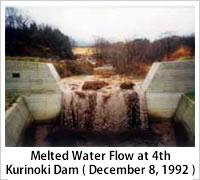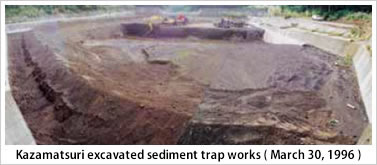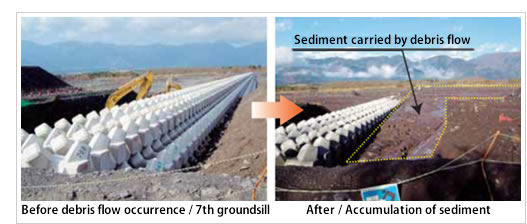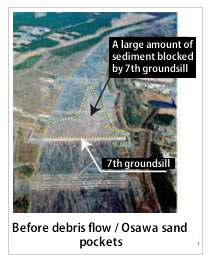Mt. Fuji & Sabo Project
Front Page>
Mt. Fuji & Sabo Project >
Sustainability >
Achievements
*yukishiro: sediment flow caused by snow avalanches or snow melting.

Achievements
Sabo facilities in the Osawa alluvial fan have caught many times of debris flow, so that damages to downstream area by debris flows have been prevented.
Recently, debris flowings were caught in November 2000 and December 2004. Osawa sand pocket facilities captured both sediments, so there were no damage to the lower reaches.
Recently, debris flowings were caught in November 2000 and December 2004. Osawa sand pocket facilities captured both sediments, so there were no damage to the lower reaches.
List of captured flows such as debris flow with the Sabo facilities
| Debris flow occurrence date | Weather factor | River name | Continuous rainfall (mm) |
Day rainfall (mm) |
Maximum amount of rainfall (mm / h) | Deposited sediment volume |
Type of Outflow |
| November 28, 1991 | bad temper | Osawa River | 226 | 166 | 39 | 182 | debris flow |
| December 8, 1992 | snow melting | Kurinokisawa River | 246 | 231 | 37 | yukishiro* | |
| March 30, 1996 | snow meilting | Kazamatsuri River | 138 | 137 | 27 | 18 | yukisiro* |
| June 20, 1997 | typhoon | Osawa River | 321 | 221 | 63 | 195 | debris flow |
| November 26, 1997 | bad temper | Osawa River | 298 | 283 | 33 | 199 | debris flow |
| November 20, 2000 | bad temper | Osawa River | 260 | 149 | 37 | 280 | debris flow |
| December 20, 2004 | bad temper | Osawa River | 162 | 106 | 31 | 110 | debris flow |
Yukishiro, December 8, 1992 |
|||||
|
|||||
yukishiro, March 30, 1996 |
|||||||||
|
|||||||||
Debris flow, November 21, 2000 |
|
| Heavy rainfall over 2 days caused the largest debris flow on record, originating in the Osawa failure. Sediment caught at the Osawa sand pocket mounted up to 280,000m3. |
|

Debris flow, December 5, 2004 |
|||||
|
|||||
Efficient Use of Sediment
Flowing out of the Osawa failure, large amounts of sediment are stopped and accumulated at our debris flow countermeasure facilities, such as the sand pocket and basins. This needs to be taken out, as it can flow out again to the under reaches and cause disasters, in case of any additional debris flow out. Thus we remove the sediment from our facilities, so their functions are maintained. We use a stock yard on the Osawa alluvial fan as a tentative storage place for removed sediments. Stocked sediment consists of various sizes of sand and rocks (some of which are 2 meters long in diameter), making it difficult for us to find private contractors who would take it in for their own use. In order to attract more contractors to accept the sediment, we started screening and fracturing the sand and rocks in 1998. Consequently, the sediment has been used for a broader range of purposes, including beach improvement materials and road bed materials. 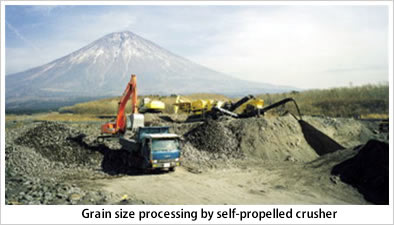 |
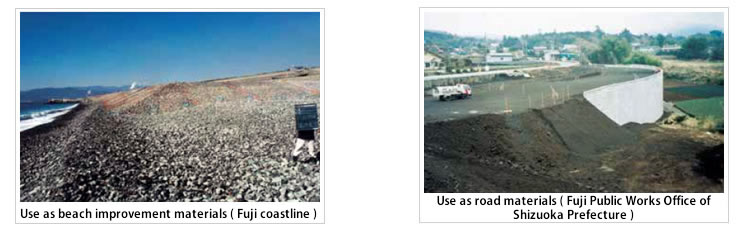 |
Copyright (c) 2006 Mt. Fuji Sabo Office, Chubu Regional Development Bureau, Ministry of Land, Infrastructure, Transport and Tourism. Allrights reserved.






















